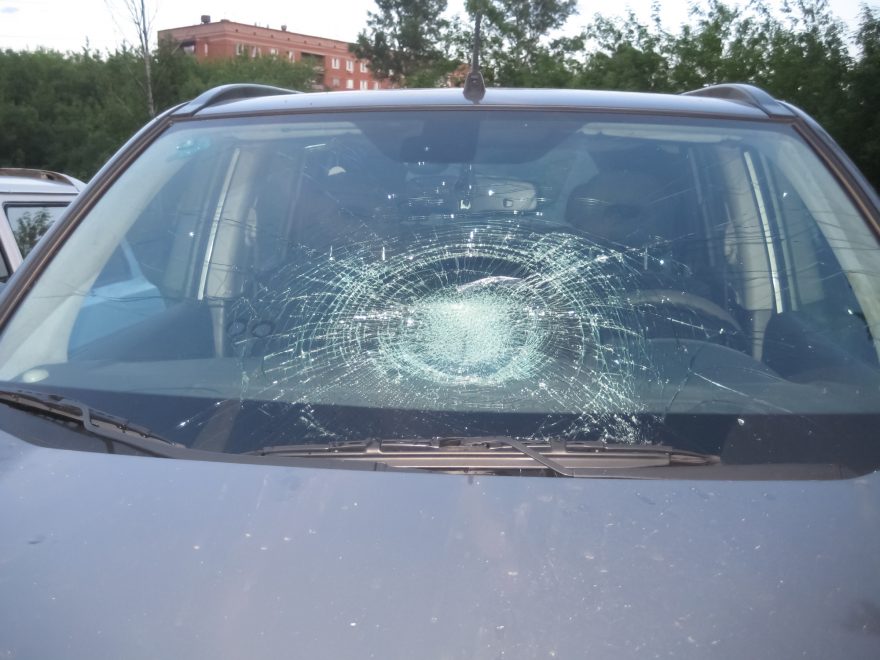Did you know that in many cars the windshield is responsible for deploying the passenger side airbag?
If you have a cracked windshield and get into a collision, the windshield may shatter. The airbag could inflate forward instead of to the side and fail to protect a passenger.
Read on for 5 things you need to know about cracked windshields.
1. Chipped Vs Cracked Windshield
There is a difference between a chipped and cracked windshield. Sometimes you might have both.
A chip is often caused by debris such as a rock that hit your glass on the freeway. You can see the point of impact on a chip. It may look like a star, a bullseye or a small gouge.
Cracks are lines in the glass. These could be under an inch long or run the entire length of your windshield.
2. Cracked Windshields Are Not Safe
Windshields are made of two pieces of safety glass with a vinyl layer in between. They have been designed to take the force of a hard impact such as a car crash. Yet, even a small crack can weaken the windshield.
Think of it like a bike helmet. If the helmet has been slightly damaged, it may not protect a child’s head properly during a fall. The same is true of windshields.
That is why it is important to make fixing cracked windshields a priority as soon as you notice a crack.
3. Can You Repair Cracks in Windshields?
Chips in windshields can almost always be repaired. Cracks, even long ones, can sometimes be repaired. Yet it depends on the size, depth and where on the windshield the crack is.
Size
Generally speaking, short cracks that aren’t deep can be repaired without a problem.
The Repair of Laminated Automotive Glass Standard guide sets limits on what type of damage can be repaired. The limit is 14 inches long. Cracks that are longer will need a whole windshield replacement.
However, each repair shop has different abilities to perform repairs. And depth and location matter too.
Depth
If a crack on your windshield is on the top layer of glass, repairs are possible. Yet, if the damage has reached the inner layer, a repair won’t be possible. Replacement is the only option at that point.
Location
Repairing cracks in windshields also depend on where on the glass the cracks are. If the crack reaches all the way to the edge of the windshield, the integrity may be compromised. In this case, replacement is the best choice.
Cracked windshield repairs do not erase the crack. It will still be visible in the glass.
So if the crack is in the driver’s line of sight, it is not safe to just repair the crack. That’s because looking through a crack on the windshield could lead to a distorted view.
If a crack has damaged any sensors your windshield may have (such as ABS or lane departure warning sensors) then a repair could cause malfunctions. In these cases, a full replacement will be needed.
4. Do Windshield Cracks Always Spread?
A crack in the windshield has the potential to spread. That does not mean that it always will. Whether or not a crack spreads depends on a few factors.
Moisture and Temperature
Water can get through a crack in a windshield. In cold weather, that water could freeze and cause the crack to spread or cause new cracks to form.
Hot temperatures expand the glass and may also cause cracks to grow.
Dirt
Dirt and other airborne particles can also find their way into the inner layers of a windshield through a crack.
These substances will weaken your windshield and make it more likely to get new chips and cracks. Check out these tips on how best to clean your car windows.
Bumpy Roads
As you drive, dips and uneven road surfaces can cause your windshield stress. This may make the crack in your windshield to spread out. Even if you drive carefully, you can’t avoid the bumps in the road.
Even a gentle bump might be enough to cause your windshield crack to spread.
Besides spreading, a windshield could also shatter. Note that shattering doesn’t mean glass will fall in bits into your lap. Windshields have special glue that makes this very unlikely.
Yet, the crack could spread into a kaleidoscope of cracks that make it impossible to drive the vehicle safely. At this point, you would need to pay for a windshield replacement. Plus you would need a tow to get your car to a nearby shop.
5. Sooner is Always Better
Each day that you wait to repair a crack in your windshield is another chance for the damage to get worse.
Using your windshield wipers fluid will push chemicals into the crack. This means that when it gets repaired, the crack won’t look crystal clear.
Dirt and other debris will make their way into the crack even if you don’t use your wipers at all. Rainwater and heat also may cause the damage to become worse.
It’s often less expensive to fix a crack in the first day or two than if you wait a month. The process is easier and the chip or crack is usually smaller.
You might be surprised to learn that you can get a traffic ticket for driving with a cracked windshield. The law varies from state to state, yet visibility is a requirement across the board. The sooner you take care of this repair, the less likely you are to get pulled over and ticketed.
Final Thoughts
We hope this article about cracked windshields was helpful. Now you know that a crack in your windshield isn’t just unsightly, it’s also dangerous. And the longer you wait, the more expensive the repair might be.
Next, read how to remove dents and scratches in your car.

